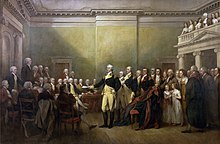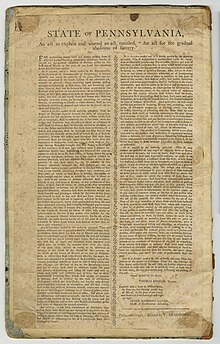Thomas Mifflin
His great-grandfather John Mifflin Jr. (1662–1714) was born in Warminster, Wiltshire, England and settled in the Province of Pennsylvania.
[3] In 1760, Mifflin graduated from the College of Philadelphia (now the University of Pennsylvania) and joined the mercantile business of William Biddle.
After returning from a trip to Europe in 1765, he established a commercial business partnership with his brother, George Mifflin.
[8] Although it has been said that he was good at the job despite preferring to be on the front lines, questions were raised regarding his failure to properly supply Washington and the troops at Valley Forge, alleging that he had instead warehoused and sold supplies intended for Valley Forge to the highest bidder.
Reportedly, after Washington confronted him about this,[9] Mifflin asked to be relieved as quartermaster general but was persuaded to resume those duties because Congress was having difficulty finding a replacement.
[10] In Congress, there was debate regarding whether a national army was more efficient or whether the individual states should maintain their own forces.
He served two terms in the Continental Congress (1774–1775 and 1782–1784), including seven months (November 1783 to June 1784) as that body's presiding officer.
Mifflin's most important duty as president was to accept on behalf of Congress the resignation of General George Washington on December 23, 1783.
After the war, the importance of Congress declined so precipitously that Mifflin found it difficult to convince the states to send enough delegates to Congress to ratify the Treaty of Paris, which finally took place on January 14, 1784, at the Maryland State House in Annapolis.
The Whiskey Rebellion and the 1793 Philadelphia yellow fever epidemic happened during his term in office.
Although Mifflin's family had been Quakers for four generations, he was expelled from the Religious Society of Friends when he joined the Continental Army, because his involvement with the military contradicted that faith's pacifistic doctrines.
[10] He served from 1773 to 1791 as a trustee of the College and Academy of Philadelphia (now the University of Pennsylvania), including two years as treasurer (1773–1775).




